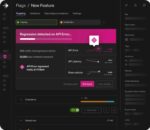
LaunchDarkly today is releasing updates to its platform to address the reality of the resource-constrained times we are in but in which developers are still expected to move at the same pace or even faster. DevOps has helped with this effort of delivering stable software quickly, keep customers happy and innovate faster than their competitors, but gaps in this effort remain.
The theme of LaunchDarkly’s Galaxy ’23 event is “the next frontier of DevOps,” in which IT and developers still have to stitch together different processes to solve bigger problems, which causes a lot of grunt work and frustration.
According to Cody DeArkland, director of developer experience at LaunchDarkly, “The thinking behind this release is, ‘hey, where are all the sharp edges, and how are people releasing features into their environments and into customer applications? What are the barriers that make this challenging?'”
To help developers connect software to the customer experience, there is a new feature called Release Assistant, which is a release pipeline tool that provides guardrails around how you ship features across multiple environments, as well as providing governance and automation. “Multiple different environments are often treated as islands. And we would have to create really complex automations to stitch those together,” DeArkland told SD Times. “There’s this separate tool that I would use to automate how something would release in dev, and then QA and production, but these were at worst individual processes that were treated completely differently.”
Release Assistant helps teams find out what that progression path looks like, and attach governance and common viewpoints to that. “A single administrator doesn’t have to balance juggling between multiple environments,” he said. “It’s just a viewpoint that they have now inside of the platform.”
According to the company’s blog announcing the product update, the new Release Assistant provides:
- The ability to align releases to organizational best practices at scale with visibility into the status of all releases across an organization.
- Best practices into reusable release pipelines so every change can follow a successful path to production and ultimately save time.
- The ability to move flags across release pipelines knowing that LaunchDarkly will send a prompt when phases are complete.
- A way to track and know the exact release status of each feature with real-time visibility across each project for all of your stakeholders.
And yet, even adhering to best practices in development does not guarantee your release will be free of bugs. A new early access tool called Release Guardian monitors metrics with the release context, according to the company, and can detect issues that otherwise might have been blocked out given all the noise in wider metrics.
Release Guardian’s capabilities are an evolution from LaunchDarkly’s platform for progressive releases, bringing real-time metric and regression monitoring through active flag change monitoring. “A good example might be something like releasing a stock trading component for a bank,” DeArkland said. “And you’re seeing that that new component has created additional latency in the platform. Maybe it’s increased user latency by 100 milliseconds. You can set these thresholds in Release Guardian and have it automatically roll that feature back if it’s seeing things that are degrading the user experience or degrading performance.”
On the flip side, he said, if things are going well, users can expand that to a broader cohort and continue down the release progression, he explained.
Other new features include a Migration Assistant, which helps organizations modernize their technology stacks and control migration through gradual rollouts, providing more safety, predictability, and visibility, the company said in its announcement. Included in this feature are new migration flag types and checks to ensure that migrated data matches up with the old datastores.
Another new feature, Segment Builder, brings enhancements to LaunchDarkly’s Segment Model, and uses targeting capabilities to make delivering the right experiences to the right audiences faster and easier, according to the announcement.
The new Funnel Experiments feature unlocks the ability to drive data-informed product updates by giving developers the ability to increase product performance by grouping experiment metrics for effectiveness.
A new Mobile Lifecycle Assistant helps optimize the application versions, and an Engineering Insights Hub brings metrics into one place to help engineers work more efficiently, according to the company.






